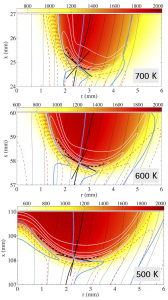Details
A tribrachial flame is an edge flame comprising two distinct premixed flame wings, one lean and one rich, and a trailing diffusion flame, all stemming from a single point (tribrachial or triple point). Tribrachial flames are observed when a flame encounters concentration gradients as it propagates in a flow field with mixture stratification. Tribrachial flames play a role in the stabilization and dynamics of laminar and turbulent flames and their propagation is relevant to the partially premixed combustion regime.
Goals
- Characterize the structure and propagation characteristics of tribrachial flames of a large hydrocarbon (n-heptane)
- Assist efforts in the experimental characterization of those flames by providing detailed information on reactive scalar fields, velocity & stretch fields and heat release rate.
- Investigate the response of trabrachial flames to varying degrees of mixture stratification.
Methods
In our work on tribrachial flames, the gas phase hydrodynamics are modeled with the reactive Navier-Stokes equations in the low Mach number limit. The transport of heat and mass is described using the Hirschfelder and Curtiss approximation to the diffusive fluxes together with a velocity-correction approach to satisfy mass conservation. The Soret and Dufour effects are neglected. The species obey the ideal gas equation of state and the simulations are conducted at atmospheric pressure. All transport properties are computed with a mixture-average approach. The solver relies on an MPI-based distributed memory parallelization strategy and is executed in parallel on the Linux cluster “Noor” available at the Clean Combustion Research Center. In order to reach steady state, the most demanding case requires approximately 240 hrs in wall-clock time (or 30,000 cpu-hours) on 128 processing cores of Intel Xeon X5570 quad-core processors.
Results
A set of tribrachial flames of n-heptane/air is simulated with finite rate chemistry and detailed transport in a realistic laminar jet configuration for which experimental data are available. The flames differ by the temperature of the unburnt mixture and stabilization height, which controls the mixture fraction gradient ahead of the flame front. The simulations reproduce the lift-off heights in the experiments, showing that the flame stabilizes further downstream as the unburnt temperature decreases. For the lowest unburnt temperature, resulting in a weak mixture fraction gradient at the tribrachial point, positive stretch along the rich premixed wing leads to an increase in the rate of chemical reaction in the whole flame.

The tribrachial flame burning velocity exceeds that in the unstretched, one-dimensional flame. For the highest temperature, the flame stabilizes closest to the nozzle. Large flame tilt, large mixture fraction gradient, and small radius of curvature lead to a reduction in the heat release rate and the flame propagates slower than its one-dimensional counterpart. The observed behavior is explained with a detailed analysis of the flame geometry, differential diffusion effects, flame stretch, and transport of heat and mass from the burnt gases to the flame front.
Publications
- F Bisetti, S M Sarathy, M Toma, and Chung S H. \Stabilization and structure of n-heptane tribrachial flames in axisymmetric laminar jets”. Proc. Combust. Inst. (2014). In press. doi: 10.1016/j.proci.2014.06.077
